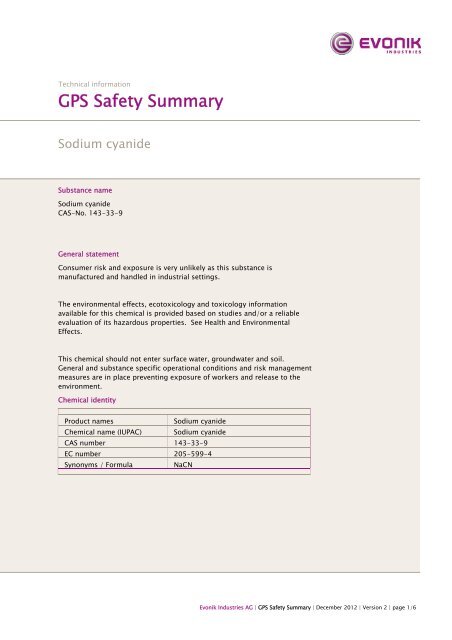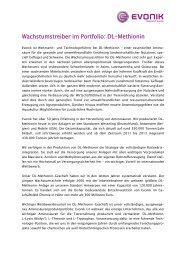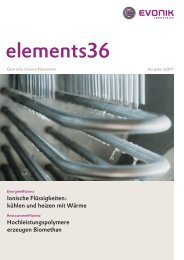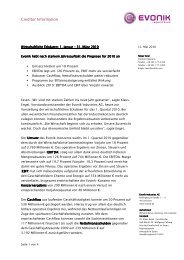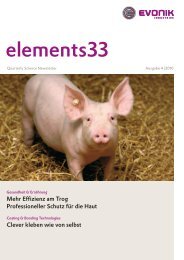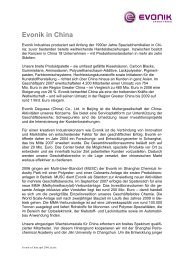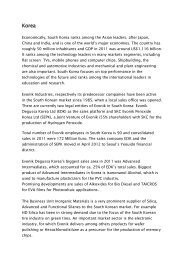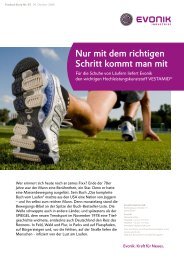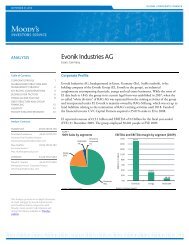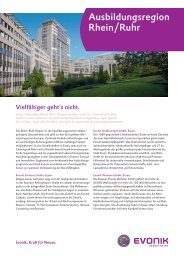Sodium cyanide - Evonik Industries
Sodium cyanide - Evonik Industries
Sodium cyanide - Evonik Industries
Create successful ePaper yourself
Turn your PDF publications into a flip-book with our unique Google optimized e-Paper software.
Technical information<br />
GPS Safety Summary<br />
<strong>Sodium</strong> <strong>cyanide</strong><br />
Substance name<br />
<strong>Sodium</strong> <strong>cyanide</strong><br />
CAS-No. 143-33-9<br />
General statement<br />
Consumer risk and exposure is very unlikely as this substance is<br />
manufactured and handled in industrial settings.<br />
The environmental effects, ecotoxicology and toxicology information<br />
available for this chemical is provided based on studies and/or a reliable<br />
evaluation of its hazardous properties. See Health and Environmental<br />
Effects.<br />
This chemical should not enter surface water, groundwater and soil.<br />
General and substance specific operational conditions and risk management<br />
measures are in place preventing exposure of workers and release to the<br />
environment.<br />
Chemical identity<br />
Product names <strong>Sodium</strong> <strong>cyanide</strong><br />
Chemical name (IUPAC) <strong>Sodium</strong> <strong>cyanide</strong><br />
CAS number 143-33-9<br />
EC number 205-599-4<br />
Synonyms / Formula NaCN<br />
<strong>Evonik</strong> <strong>Industries</strong> AG | GPS Safety Summary | December 2012 | Version 2 | page 1/6
Uses and application<br />
<strong>Sodium</strong> <strong>cyanide</strong> is used primarily as starting material in the manufacture of<br />
other chemicals. The substance is used for extraction and recycling of<br />
precious metals, as a processing aid in electroplating and as a surface<br />
treatment agent in metal hardening.<br />
Physical/chemical properties<br />
<strong>Sodium</strong> <strong>cyanide</strong> is a white crystalline solid with a faint bitter-almond like<br />
odour. The solid has a density higher than water. The melting point of this<br />
substance is 562 °C and the boiling point 1500 °C. Alkali <strong>cyanide</strong> salts are<br />
soluble in water liberating HCN unless pH is strongly alkaline.<br />
Property Value<br />
Density 1.595 g/cm3 (20°C)<br />
Melting / Boiling point 562°C / 1500°C<br />
Molecular weight 49.0072 g/mol<br />
Health effects<br />
Based on available data, <strong>Sodium</strong> <strong>cyanide</strong> is fatal if swallowed, inhaled and<br />
absorbed through the skin. Standard tests indicate the substance is not<br />
mutagenic or genotoxic. Data shows no evidence of reproductive toxicity or<br />
carcinogenicity.<br />
Effect Assessment Result<br />
Acute toxicity (oral, dermal Fatal if swallowed, inhaled and<br />
and inhalation)<br />
absorbed through the skin.<br />
Eye / Skin irritation Due to the acute toxicity the irritative<br />
effect on the eye and skin cannot be<br />
determined.<br />
Sensitization Due to the acute toxicity the sensitizing<br />
potential cannot be determined.<br />
Toxicity after repeated<br />
Acutely toxic effects are predominant<br />
exposure<br />
via oral, dermal and inhalative route.<br />
Repeated exposure is correlated with<br />
thyroid enlargement.<br />
Genotoxicity / mutagenicity Not mutagenic / not genotoxic<br />
Carcinogenicity No evidence that the material is<br />
carcinogenic based on available data.<br />
Toxicity for reproduction No evidence that the material is a<br />
reproductive toxin based on available<br />
data.<br />
<strong>Evonik</strong> <strong>Industries</strong> GmbH | GPS Safety Summary| December 2012 | Version 2 |page 2/6
Environmental effects<br />
Based on available data, <strong>Sodium</strong> <strong>cyanide</strong> is considered very toxic to the<br />
environment. The substance is readily biodegradable and no<br />
bioaccumulation is expected. Cyanide is a naturally occurring substance<br />
produced by certain plants, algae and bacteria.<br />
Effect Assessment Result<br />
Aquatic toxicity Very toxic to water organisms<br />
Fate and Behavior Result<br />
Biodegradation Readily biodegradable<br />
Bioaccumulation potential No bioaccumulation potential<br />
PBT / vPvB conclusion Not considered to be either PBT or vPvB<br />
Exposure<br />
Human health<br />
Consumers will not come into contact with <strong>Sodium</strong> <strong>cyanide</strong> since there are no<br />
known consumer uses for <strong>Sodium</strong> <strong>cyanide</strong>. It is industrially manufactured in a<br />
closed process. Personnel exposure to <strong>Sodium</strong> <strong>cyanide</strong> in the manufacturing<br />
facilities is minimized by general and substance specific operational<br />
conditions and risk management measures. When containers and tanks are<br />
cleaned, residues are captured and detoxified. Storage and manufacturing<br />
facilities are built to safely handle <strong>Sodium</strong> <strong>cyanide</strong> and precautions are taken<br />
to capture any unintended releases. All workers are trained in the properties<br />
of <strong>Sodium</strong> <strong>cyanide</strong> and safe practices including using personal protective<br />
equipment.<br />
Environment<br />
<strong>Sodium</strong> <strong>cyanide</strong> is manufactured in a closed and automated process, thus, no<br />
release to the environment is intended.<br />
Risk management recommendations<br />
When handling <strong>Sodium</strong> <strong>cyanide</strong>, follow specific operational instructions in<br />
place. Make sure that there is adequate ventilation. Always use appropriate<br />
chemical resistant gloves to protect your hands and skin and always wear eye<br />
protection such as chemical goggles. Provide a safety shower and a<br />
respirator with appropriate filter to be available for immediate use. Do not<br />
eat, drink, and smoke where the substance is handled, processed or stored.<br />
All wastewater streams that may include the substance must be directed to a<br />
wastewater treatment plant that removes the substance from the final<br />
releases to the receiving water. Dispose of the substance and its container<br />
only at hazardous or special waste collection points.<br />
<strong>Evonik</strong> <strong>Industries</strong> AG | GPS Safety Summary | December 2012 | Version 2 | page 3/6
State agency review<br />
• NIOSH (1976). Occupational exposure to hydrogen <strong>cyanide</strong> and<br />
<strong>cyanide</strong> salts (NaCN, KCN and Ca(CN)2). Criteria for a recommended<br />
standard. National Institute for Occupational Safety and Health, Cincinnati,<br />
Ohio, USA [NTS PB 266230]. Report no.: 77-108.<br />
• Scientific Committee on Occupational Exposure Limits (2005).<br />
Recommendations from Scientific Committee on Occupational Exposure<br />
Limits for Cyanide (HCN, KCN, NaCN). SCOEL/SUM/115 May 2005. Report<br />
no.: 115.<br />
• WHO (1993). Cyanogenic Glycosides. WHO Food Additives Series,<br />
Report no. 30.<br />
• U.S. National Advisory Committee (NAC) to develop AEGLs (2000).<br />
Hydrogen <strong>cyanide</strong>, proposed acute exposure guideline levels (AEGLs).<br />
Unpublished report proposed January, 2000. National Advisory Committee to<br />
develop AEGLs. US Environmental Protection Agency, Washington DC, USA.<br />
• U.S. Water Environment Research Foundation (2003). Reassessment<br />
of <strong>cyanide</strong> criteria for the protection of aquatic life and wildlife, Alexandria,<br />
VA, USA, Report 01-ECO-1.<br />
also see<br />
• ECETOC (2007). Cyanides of Hydrogen, <strong>Sodium</strong> and Potassium, and<br />
Aceton Cyanohydrin (CAS No. 74-90-8, 143-33-9, 151-50-8 and 75-86-5).<br />
Joint Assessment of Commodity Chemicals (JACC), Report no.: 53.<br />
<strong>Evonik</strong> <strong>Industries</strong> AG | GPS Safety Summary | December 2012 | Version 2 | page 4/6
Regulatory information/classification and labelling<br />
GHS-Labeling<br />
Statutory basis EU-GHS as per Regulation (EU) No. 1272/2008 (CLP)<br />
Symbol(s)<br />
Signal word Danger<br />
Hazard Statements H290: May be corrosive to metals.<br />
H300: Fatal if swallowed.<br />
H310: Fatal in contact with skin.<br />
H330: Fatal if inhaled.<br />
H370: Causes damage to organs.<br />
H372: Causes damage to organs through prolonged or<br />
repeated exposure.<br />
H410: Very toxic to aquatic life with long lasting effects.<br />
More information about <strong>Sodium</strong> <strong>cyanide</strong> can be found in the<br />
Safety Data Sheet.<br />
Precautionary statements P270: Do not eat, drink or smoke when using this product.<br />
P273: Avoid release to the environment.<br />
P280: Wear protective gloves/protective clothing/eye<br />
protection/face protection.<br />
P301+P310: IF SWALLOWED: Immediately call a POISON<br />
CENTER or doctor/physician.<br />
P302+P352: IF ON SKIN: Wash with plenty of soap and water.<br />
P304+P340: IF INHALED: Remove victim to fresh air and keep<br />
at rest in a position comfortable for breathing.<br />
P403+P233: Store in a well-ventilated place. Keep container<br />
tightly closed.<br />
<strong>Evonik</strong> <strong>Industries</strong> AG | GPS Safety Summary | December 2012 | Version 2 | page 5/6
This GPS Safety Summary is based on <strong>Evonik</strong>’s present knowledge and experience as of the date of<br />
issue. However, it implies no liability or other legal responsibility on the part of <strong>Evonik</strong>, including<br />
with regards to existing third party intellectual property rights, especially patent rights. In no event<br />
shall <strong>Evonik</strong> be responsible for damages of any nature whatsoever resulting from the use of or<br />
reliance upon the information herein or the chemical to which that information refers. In particular,<br />
no warranty, whether expressed or implied, or guarantee in the legal sense is intended or implied<br />
by <strong>Evonik</strong>.<br />
This GPS Safety Summary is only intended to provide general information about the chemical<br />
referred to herein but not any in-depth health and safety information. The information in this GPS<br />
Safety Summary is supplied on the condition that the persons receiving the same will make their<br />
own determination as to its suitability for their purposes prior to use. This GPS Safety Summary<br />
does not supersede or replace required regulatory and/or legal communication documents.<br />
Performance of the chemical described herein should be verified by testing which should be carried<br />
out only by qualified experts.<br />
<strong>Evonik</strong> reserves the right to make any changes to this GPS Safety Summary in accordance with<br />
technological progress or further developments. Reference to trade names used by other<br />
companies is neither a recommendation, nor does it imply, that similar products could not be used.<br />
Glossary<br />
Acute toxicity harmful effects after a single exposure<br />
Biodegradable breakdown of materials by a physiological environment<br />
Bioaccumulation accumulation of substances in the environment<br />
Carcinogenicity effects causing cancer<br />
Chronic toxicity harmful effects after repeated exposures<br />
GHS Global Harmonized System on Classification and Labeling<br />
Mutagenicity effects that change genes<br />
PBT Persistent Bioaccumulative Toxic<br />
Reprotoxicity combining teratogenicity, embryotoxicity and harmful effects on fertility<br />
Sensitizing allergenic<br />
Teratogenic effects on foetal morphology<br />
vPvB very Persistent very Bioaccumulative<br />
Contact information within company<br />
Email address EU FA-MSDS@evonik.com<br />
USA product.regulatory.services@evonik.com<br />
Emergency Telephone number EU +49 (0)2236 76-2222<br />
USA 800 424-9300 (CHEMTREC)<br />
Emergency Telefax number EU +49 (0)2236 76-2026<br />
December 2012


